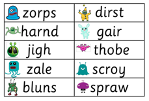Phonics at St. Patrick’s
Reading Support Leader – Mrs Ryan
At St Patrick’s, we strive to teach children to read effectively and quickly using the Read Write Inc. Phonics programme (RWI) which includes teaching synthetic phonics, sight vocabulary, decoding and encoding words as well as spelling and accurate letter formation.
Reading
Fred the Frog puppet plays an important role in our RWI lessons. Fred is only able to speak in sounds, not whole words. We call this Fred Talk.
For example, Fred would say s- a – t, we would say sat. Fred talk helps children read unfamiliar words by pronouncing each sound in the word one at a time. Children can start blending sounds into words as soon as they know a small group of letters well. During lessons children are taught to hear sounds and blend them together in sequence to make a word. We start with blending oral sounds, then progress to reading the letters and blending them together to read the word.
The following video is an example of blending sounds with Fred: Blending Sounds
Order of Teaching Sounds
In RWI the individual sounds are called ‘speed sounds’ – because we want your child to read them effortlessly. Set 1 sounds are the initial letter sounds. They are taught in the following order.
m, a, s, d, t, i, n, p, g, o, c, k, u, b, f, e, l, h, sh, r, j, v, y, w, th, z, ch, qu, x, ng, nk
There are 12 Set 2 ‘speed sounds’ that are made up of two or three letters which represent just one sound, e.g. ay as in play, ee as in tree and igh as in high.
When children learn their Set 2 sounds they will learn:
- the letters that represent a speed sound e.g. ay
- a simple picture prompt linked to the ‘speed sound’ and a short phrase to say e.g. may I play
Every speed sound has a list of green words linked to it, so your child can ‘sound out’ and ‘sound blend’ words containing the new speed sound they have just learnt, for example s-p-r-ay = spray.
When learning their Set 3 speed sounds they will be taught that there are more ways in which the same sounds are written, e.g. ee as in tree and ea as in tea.
Please click here to see a table showing the sounds, the associated phrase and example green words.
Click the link below to hear how to pronounce the sounds correctly: How to Say the Sounds
Nonsense words (Alien Words)
 As children build up their knowledge of sounds they are able to apply their decoding skills to any unfamiliar word may it be real or nonsense. During lessons each day children will practice their decoding skills by sounding out the letters in ‘Alien words’. Children are unable to rely on existing knowledge of real words, and instead have to use their letter-sound knowledge. This is an important part of the Phonics Screening Test children complete at the end of year 1.
As children build up their knowledge of sounds they are able to apply their decoding skills to any unfamiliar word may it be real or nonsense. During lessons each day children will practice their decoding skills by sounding out the letters in ‘Alien words’. Children are unable to rely on existing knowledge of real words, and instead have to use their letter-sound knowledge. This is an important part of the Phonics Screening Test children complete at the end of year 1.
The following websites have enjoyable games for your child to play to practice their reading of alien words.
We begin the programme in Reception and continue to use the RWI techniques to children beyond the age of 7 if they still need support in their reading. The structure of the lessons are as followed;
Word Time Lessons
As soon as children have learnt a few initial letter sounds they begin to learn to blend the sounds together to read real words. Each word time session involves oral blending of known sounds before they are shown the words written down on green cards. Children practice Fred talking the words until they become able to read them on sight. Ditty lessons follow on from this where children who are becoming excellent at reading single words are introduced to reading whole sentences. Once children are confident reading the short sentences they are challenged to use their developing phonic knowledge to write a sentence.
Storybook Lessons
The next stage of the RWI scheme is for children to read storybooks that are closely matched to their developing phonic knowledge. The storybooks consist of green words linked to the sounds they have been learning, red word (words that are not decodable) and challenge words to extend children’s vocabulary. After children have practiced these words individually they are prepared to see them in context in the story.
Activities such as comprehension questions, partner discussion and writing activities based on the book follow. You may have heard your child talking about ‘hold, edit or build a sentence’. Hold a sentence is an activity that encourages children to remember a whole sentence while focusing on spelling and punctuation. Build a sentence is to give children the opportunity to create their own sentence to that shows the meaning of a word and edit a sentence allows the children to critique a sentence using their knowledge of spelling punctuation and grammar.
Spelling with your Fred Fingers
Children are taught to use their fingers to help them write words. The children say the word out loud and break it down into its individual sounds. If a word has 3 sounds children hold up 3 fingers, 4 sounds 4 fingers etc. Children then pinch each finger as they say the sounds needed in the word then they write the letters that represent each sound.
- m a t
- p u sh
When using Fred Fingers each finger represents one sound. When children reach yellow books they will begin to learn to trace the letters onto each finger and say the letter names.
Ruth Miskin the founder of Read Write Inc. has complied a selection of videos that give lots more information and examples.
Click here to find out how you can help your child with phonics and reading at home;
- Saying sounds correctly
- Linking sounds to letters
- Two letters, one sound
- Practise, practise, practise
- Putting sounds together to read simple words
- Tricky words
- Reading books
- Using pictures
- Writing letters
Parent Phonics Film
Please click on the links below , they will help support your with phonics:
RWI Documents



